24 April 2020 : Home learning
It’s Friday already! Have some fun with the Emoji tasks today. You could do a test on your spellings and times tables today.
Maths
Work out the answers to the Emoji codes.
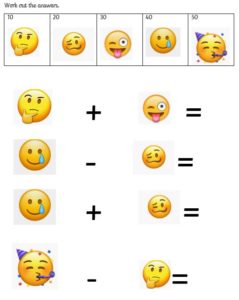
Challenge : Create your own emoji code.
Reading
Read the story about the Meerkat with Big Ears. Can you spot all the ‘ear’ trigraphs (three letters that make one sound). Write a list of what you find.
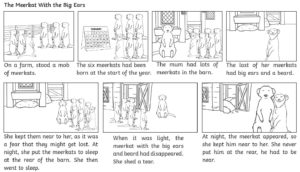
Challenge : Write a list of other words that have the ‘ear’ trigraph in them. Put each word into a sentence.
Topic – Art
Draw your favourite Emoji.
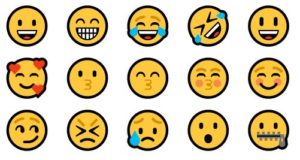
Challenge : Make up your own Emoji.
24 April 2020: Home Learning
You made it to the end of the week- well done.
Yesterday, I enjoyed doing some science outside with George and Harry in the sun. We tested hand wash, shampoo and washing up liquid to see which one made the tallest ‘bubble tower’! They decided washing up liquid was the most effective.
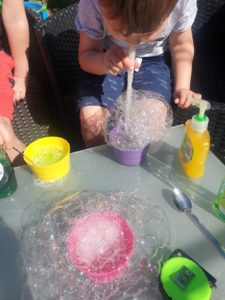
Answers to yesterday’s maths.
Today’s learning……….
Maths: fractions
Can you found examples of ‘real-life’ fractions in your home? Here are some ideas to help you. Take some pictures and email any you find. nataliebeatson@spherefederation.org
Writing: a challenge from Mr Roundtree……..
24 April 2020: Home learning
Happy Friday!
Well done for your first week ‘back’ into this new term. Are any of you doing fancy dress Friday with Joe Wicks? I’m trying to do the workouts but haven’t managed the fancy dress bit yet! Enjoy your last learning tasks of the week.
Maths: Yesterday’s answers; Year 3 and Year 4 Wake up, shake up with Supermovers: The 8x table with Filbert Fox. Today’s activity: Year 3 – multiply by 2, 4, 8 and Year 4 – 3 digit by 1 digit multiplication
Everyone complete your weekly times tables check. https://mathsframe.co.uk/en/resources/resource/477/Multiplication-Tables-Check Make sure your record your score on the sheet and find out which ones you have struggled with.
Reading: Layers of the Rainforest. (Answers are on the second sheet.)
Topic: How did you get on with yesterday’s towns and cities quiz? Answers. Today we are looking at counties in the UK. We are in West Yorkshire.
Spellings: Ask an adult to choose 10 of the 11 words from this week’s spelling list and test you on them. Can you get them all correct?
exciting learning activities to do at home.
23 April 2020 : Home learning
Good morning. Here are the learning tasks for today.
Maths
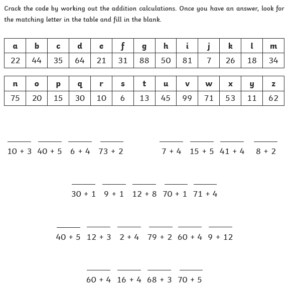
Challenge : Create your own code that reveals a message.
Reading
Watch the short film about a girl and some bubbles and answer the questions below – https://www.literacyshed.com/bubbles.html#
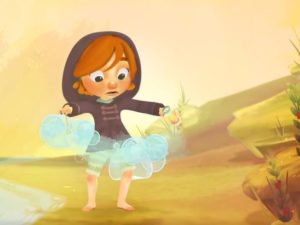
How was the girl feeling at the start of the film?
What question would you like to ask her?
Why did she leave the bubbles on the beach?
Where would you like the bubbles to take you?
Challenge : Draw and label the land the bubbles take you to.
Topic – Languages
Have a go saying hello in different ways. There are some ideas below.

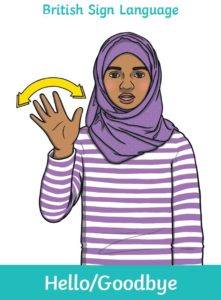
Challenge : Make own handshake or greeting to say hello.
23 April 2020: Home learning
Hi everyone,
I love a good laugh. Anyone know any good jokes? If you email me your jokes, I’ll post the best ones in our class news page. Happy learning!
Maths: Yesterday’s answers; Year 3 and Year 4 Wake up, shake up with Supermovers: The 8x table with Filbert Fox. Today’s activity: Year 3 – division by 8 and Year 4 – revising multiplying 2-digit by 1-digit.
Reading: Yesterday’s answers. Today’s activity: Gary’s Big Adventure (the answers are on the second page).
Topic: Last half term we focused on History. This half term we will be studying Geography. Towns and cities in the UK.
Handwriting: Complete the second of your handwriting sheets – these are in your learning packs. (There is a spare copy here!) The words that you are practising to write neatly are part of the Y3/4 word list.
23 April 2020: Home Learning
Happy Thursday! This week seems to be going very quickly for me- how is it going for you? I hope you’re getting back into a routine and staying happy and healthy.
Here are the answers to yesterday’s maths.
Today’s learning…….
Maths: multiplying fractions
Y6: To multiply fractions, you need to multiply the numerators together and multiply the denominators together. Watch the BBC video to remind you of how we do this.
Football fractions challenge- test yourself with Gary Lineker!
Writing: modal verbs
Yesterday, I signposted you to an online lesson on BBC Bitesize all about verbs and modal verbs. Today, complete this activity to see how much you can remember about modal verbs.
Geography: The Lake District
On Tuesday, I asked you to find mountain regions in the UK. Today, I would like you to focus on one region: The Lake District. Do you know where in the UK it is? Follow the BBC Bitesize lesson to find out more about this area and find out some facts!
22 April 2020 : Home learning
Bonjour! We often like to say hello in different ways during the register. Which other ways do you know?
Remember to read today.
Maths
Look at the repeating patterns. Copy and complete them.
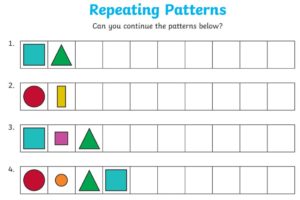
Challenge : Make some shape/colour repeating patterns of your own. Look around your house to see if there are any more repeating patterns you can see?
Reading
Look at the funny postcard. Write a list of words that you can see in the postcard. Use your phonics and knowledge of tricky words to spell the words you use.
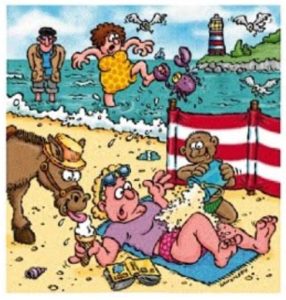
Challenge : Write sentences describing what is happening in the picture.
Topic – History
Read the information about the Queen.
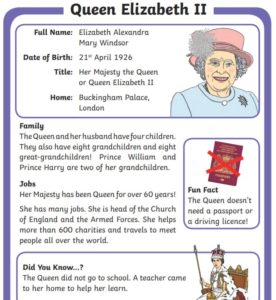
Answer the questions.
- What is the Queen’s full name?
- How many children does the Queen have?
- Who are two of her grandchildren?
- How long has she been the Queen for?
- What doesn’t the Queen need?
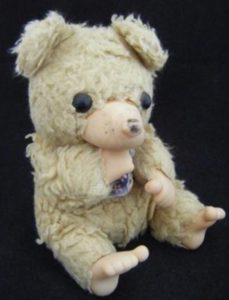
The bear from yesterday belonged to Mrs Latham. She got it in about 1978 when she was a little girl (well before Miss Harker was born), over 40 years ago ! She called it Barnaby and played with it a lot. It was special because it could suck its thumbs and toes.
22 April 2020: Home Learning
I hope you’ve enjoyed the sunshine alongside doing some learning. This week, one task each day will involve going onto the BBC Bitesize website to complete a lesson. If you have any problems then please let me know.
The answers to yesterday’s maths.
Today’s learning……..
Maths: multiplying fractions
Year 5 unit fraction x whole number
Year 6 mixed number x whole number
Reading: comprehension
Read the text about video games and answer the questions. The answers are at the bottom of the questions- don’t look until you’ve finished!
Writing: passive and active verbs
We have looked at identifying and using active and passive verbs last term. Complete this lesson by reading some tips, watching a video and completing an activity.
22 April 2020: Home learning
Happy Wednesday – half way through the week already!
How are you all feeling? Are you learning different ways of doing things during Lockdown? What are you finding harder? It’s all rather strange, isn’t it? I’m developing my computer skills and finding different ways to communicate with friends and family near and far. You can email us both to let us know how you are.
kerensawelsby@spherefederation.org
beckyrowley@spherefederation.org
Maths: Yesterday’s answers: Year 3 and Year 4. Today’s learning: Year 3 -Dividing by 4 and Year 4 – Applying mental multiplication If I know 3 x 4 = 12, then I know 30 x 4 = 120
Reading: The tunnel
Writing:
We are learning about adverbs. Watch the two clips from BBC bitesize to remind you.
Read the example ‘My narrow escape from the leopard‘: Impala and leopard recount. Identify and highlight any adverbs or adverbial phrases for WHEN, WHERE or HOW. You could also copy them into your book and make your own bank of adverbials.
Challenge: You could create some of your own sentences using adverbs and adverbials about the Impala and the leopard. Use the adverbial phrase mat and fronted adverbials to help you.
21 April 2020: Home Learning
I hope your first day back at ‘home school’ went OK.
Here are the answers to the maths fluency questions for Monday’s learning.
Year 5
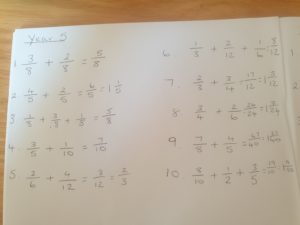
Year 6
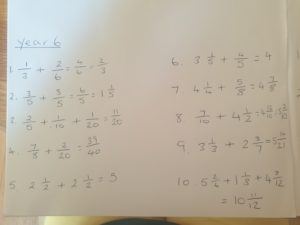
Maths learning: subtracting fractions
Remember, you need to make the fractions have the same denominator by finding a common multiple.
Writing: verbs and modal verbs
The BBC Bitesize website has some daily lessons for you to follow in various subjects and topics. Today, I would like you to revise all your knowledge of verbs and modal verbs by following this online lesson.
Geography: rivers and mountain ranges
How did you get on with naming the rivers of the UK yesterday?
Test your river knowledge today with this online quiz. How many can you get correct?
Can you use an atlas or an online map to locate the mountain ranges in the UK? Use this map to label each one.
Why don’t you make your own quiz and test your family on their river and mountain knowledge!